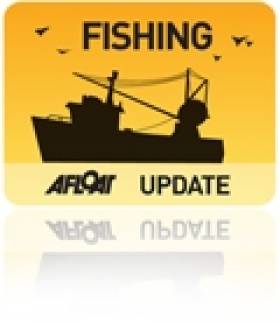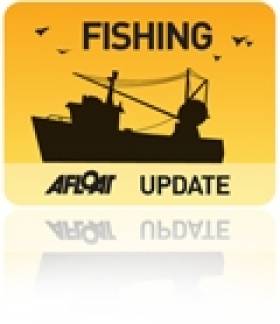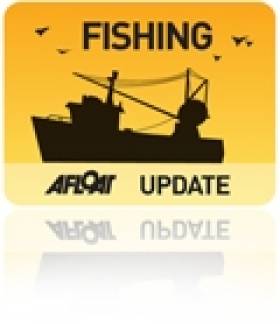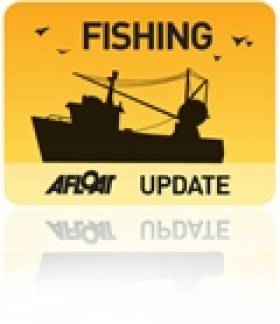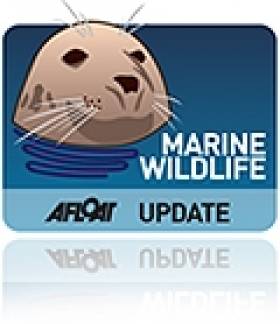Displaying items by tag: Fishing
Giant Monkfish Among West Coast Fishermen's Strange Catches
#Fishing - Irish fishermen have reported some unusual catches in recent days, according to The Irish Times.
Galway trawler Martins Marie brought home a massive lobster weighting almost 3kg with a carapace of more than 15cm.
But Rossaveal vessel Virtuous did one better on their trip to the Porcupine Bank by landing a giant monkfish that weighed in at 40kg even after gutting.
The Irish Times has more on this story HERE.
Coveney Secures Agreement to Prepare for Trade Restrictions Against Iceland and Faroes
#mackerel – Minister Simon Coveney T.D., supported by the UK, France and Spain today at the Council of Ministers today pushed strongly to have trade restrictions imposed immediately by the EU Commission against Iceland and the Faroe Islands as a result of their continued unacceptable and irresponsible fishing of mackerel. Both Iceland and the Faroese have set large unilateral quotas at unsustainable levels in 2013. Their unilateral quotas amount to 52% of the recommended scientifically advised catch of mackerel in 2013.
This is the fifth year in which Iceland has refused to engage in meaningful negotiations with the EU and Norway, the recognised major shareholders in this fishery. Both Iceland and the Faroes have developed a large and unsustainable fishery of mackerel from a situation in 2006 when they had a combined total share of only 5% of the fishery.
Minister Coveney said "I called for and secured the agreement of Commissioner Damanaki that the EU will immediately prepare for trade restrictions against Iceland and the Faroe Islands. I received strong support from many Member States including the UK, France, Spain, Portugal, the Netherlands. Both Iceland and the Faroes have repeatedly refused to engage in any meaningful negotiations with the EU and Norway over the past 5 years. This is simply unacceptable as they are now fishing over 50% of the scientifically recommended catch level for mackerel. I am pleased that the Commissioner and most Member States supported moving quickly during this fishing season to take strong and decisive measures.
We have been left with no choice and must act against these countries being rewarded by their unsustainable and irresponsible behaviour. I regret that we have been forced to take this action but the continued absence of any meaningful attempt to negotiate by either country has left us with no alternative."
The North East Atlantic mackerel fishery, if fished within recommended levels, is worth about €1 billion with a value to the European Union , as the largest shareholder, estimated to be over €600 million.
Minister Coveney added "mackerel is our most important fishery worth over €125m to us and Irish fishermen are hugely dependant on it and cannot accept their livelihoods being threatened in this way.
If this irresponsible fishing is allowed to continue this stock will be decimated and our fishermen and coastal communities will have their livelihoods completely undermined. There are many fish processing factories in Donegal and also factories in Galway, Kerry and Cork dependent on this stock. I am compelled to do all I can to protect this Irish industry and all the jobs it provides.
I have been calling consistently for the implementation of trade measures for more than 12 months and today the Commissioner has agreed to proceed to implement these measures."
Fisherman Drowned 100 Metres From Shallows Says MCIB Report
#MCIB - Various factors - including poor buoyancy, suboptimal lifejackets and a fateful late decision to swim to shore - have been identified in the official report into the death of a fisherman off the Waterford coast earlier this year.
As previously reported on Afloat.ie, a major search and rescue operation was launched on 10 January when a 16-foot fishing punt capsized in a strong swell at the sandbar off Brownstown Head near Dunmore East, throwing its two-man crew overboard.
James Tate was able to swim to the nearby shore in the early morning darkness after some two hours in the water. But he became separated from his friend Johnny Flynn - a former member of the Dunmore East lifeboat crew - who was found unconscious in the water by coastguard helicopter before 8.30am.
Flynn was pronounced dead at Waterford Airport shortly after, with a post-mortem concluding that he cause of death was drowning.
The tragedy occurred six years to the day after the sinking of Dunmore East trawler the Pere Charles, which took five lives.
In the official report into the incident, the Marine Casualty Investigation Board (MCIB) found that the fishing punt, already vulnerable to breaking waves as an un-decked open boat, was more susceptible due to its waterlogged condition, and the lack of adequate buoyancy.
It was also found that neither the vessel's handheld VHF radio nor GPS device, or indeed Tate's mobile phone, were available to the pair after the boat turned turtle.
Though both men were wearing lifejackets, they were of a kind that lacked a collar that would have kept the deceased's head above water, nor did they have a light or whistle. Only Tate was equipped with any kind of light, so he could not locate his friend in the dark.
Most importantly, it was found that the boat had overturned within 100 metres of the shallows, so that if the pair had attempted to swim to shore earlier - rather than tire themselves out trying to climb onto the upturned hull - the chances of both men surviving the incident "would have been greatly enhanced".
The full report into the incident is available to download below.
Coveney Blasts Iceland's 'Irresponsible' Mackerel Quota
#Fishing - Mackerel quotas will be the focus of discussions among European fisheries ministers in Brussels today as Ireland seeks a reduction of Iceland's share.
As RTÉ News reports, Marine Minister Simon Coveney will seek "strong and decisive action" against Iceland and the Faroe Islands unless the European Commission reports progress in talks over the realignment of mackerel catch limits.
Iceland's quota for mackerel increased from 2,000 tonnes in 2009 to a whopping 146,000 tonnes just two years later as stocks of the staple fish soared - partly due to migration from more southerly European waters.
But Minister Coveney has blasted Iceland's move as "irresponsible and unacceptable fishing".
The talks come in the wake of fruitful reform of the Common Fisheries Policy led by the minister as president of the EU Fisheries Council during Ireland's EU Presidency in the first half of this year.
CFP Reform Reaches Final Hurdle In Brussels
#CFP - RTÉ News reports that the "final battle" before reform of the Common Fisheries Policy (CFP) comes up today as a European Parliament committee votes on the changes led by the Irish Presidency of the EU in the first half of this year.
As previously reported on Afloat.ie, Europe's fisheries ministers agreed in May to a new policy that sets quotas based on scientific advice, with the aim of achieving healthy fish stocks and ultimately higher quotas as stocks are managed sustainably.
The reforms were pushed by Marine Minister Simon Coveney during his presidency of the EU Fisheries Council. The minister also made as his priority the ending of the practice of fish discards, a subject of much public outcry following revelations that as much as 50% of the catch in the North Sea is thrown back dead in the water.
Meanwhile, Ireland's additional quotas under the Hague Preferences have also been retained, a move that comes as some relief to the Irish fishing industry - which will also benefit from CFP amendments that would support the renewal of older fishing fleets.
However, conservation groups fear that these proposals would see the EU's fishing fleets grow to a size that far exceeds the available fisheries resource in European waters.
#Fishing - The Irish Times reports that Inland Fisheries Ireland (IFI) has expressed "serious concerns" over the findings of a new study on wild salmon in Ireland.
The State agency for Ireland's fisheries argues that the study - which concluded not only that pollution has a greater impact on wild salmon numbers than fish farming, but also that salmon catchments in close proximity to aquaculture schemes were some of the best performing - is based on flawed methodology.
IFI is among the chorus of voices opposed to the planned organic salmon farm off the Aran Islands in Galway Bay - a 500-hectare project by Bord Iascaigh Mhara (BIM) that would be the largest of its kind in Europe if given the go-ahead.
Marine Minister Simon Coveney recently attempted to alleviate concerns over the controversial scheme, claiming there would be no damage to the environment or fish stocks.
However, the controversy doesn't end there, as last month celebrity chef and 'Slow Food' champion Darina Allen wrote to the minister over erroneous claims in BIM's environmental impact statement (EIS) for the project.
As reported by the Galway Independent, Allen contacted Minister Coveney to clarify that the Slow Food movement does not support fish farming projects, after references to the initiative in the EIS "seemed to create a lot of confusion".
Allen told the paper: “Many people contacted me under the perception that Slow Food endorsed the whole salmon farm thing and actually Slow Food has made no statement whatsoever on it.”
Later, Michèle Mesmain of Slow Food International confirmed that “salmon farming does not fit in any pillar of Slow Food”.
The Galway Independent has much more on the story HERE.
#fishing – A key aspect of new state safety packages for fishermen unveiled today is the use of EPIRBS which are to be made mandatory overtime and included in revised Fishing Vessel Code of Practice.
Minister for Transport, Tourism and Sport, Leo Varadkar, TD, with responsibility for maritime safety regulation and emergency response, and Minister for Agriculture Food and Marine, Simon Coveney, TD, with responsibility for the fishing industry, jointly launched a multi-faceted, cross Departmental, Cross Agency safety initiative for the Irish Fishing Industry in Union Hall today.
Grant aid is being made available for float-free, automatically activated EPIRBs (electronic position indicating radio beacons) for fishing vessels of less than 15 metres. The scheme will be operated by Bord Iascaigh Mhara and cover 60% of the cost of equipment for smaller vessels under 12 metres, and 40% of the cost for larger vessels. This is the single most significant safety enhancement of the scheme announced today. The grants can be used to purchase new units or to retrofit or replace old, manually operated beacons.
Grants will also be provided for Personal Locator Beacons which will be made mandatory for vessels of 15 metres or less, and included in the Fishing Vessel Code of Practice.
The initiative is supported by both Departments and their respective agencies and features the following:-
– Provision of Vessel & personal locator beacons.
– A new enhanced Safety Equipment Grant Aid Scheme operated by BIM for the purchase of:
– Personal Locator Beacons (PLBs)
– Personal Locator Beacons integrated into Personal Flotation Devices (PFD/PLB's)
– Float Free – self activating Electronic Position Indicating Radio Beacons (EPIRBS)
– Auto Pilot Alarms
– Wireless engine cut offs
Revised Fishing vessel Code of practice to be tougher and amended to take account of lessons learnt from recent tragedies.
A New Marine Notice being drafted on use of lifejackets.
· The establishment of a high level working group on safety in the Irish fishing industry.
· A new National Maritime Safety and Emergency Response Strategy to be launched.
· An new enhanced Safety Training Course run by BIM on a five year cycle
Minister Coveney said; "This cross Departmental initiative launched here today is testament to this Governments commitment to improving safety in our fishing fleet. It is about learning from past tragedies, and saving lives in the future."
Minister Varadkar said: "It is appropriate that the launch of this important maritime safety initiative targeted at the fishing sector is taking place here in Union Hall. Those tragic events of January 2012 left a huge impact on the nation as a whole, and reminded the nation of the dangers of the sea. The first ever national maritime safety strategy announced today is about closing any gaps in services, preventing accidents at sea, and through consultation with stakeholders and the general public, striving to reach a situation where we have no fatalities at sea. The launch of BIM's scheme backed up with the changes to the Code of Practice and a continued commitment to regulation and compliance with safety standards will help to engrain a culture of 'safety-first' on the water."
Minister Coveney explained " I am making €800,000 available over the next three years to fund this scheme and aligned with the new excellent enhanced safety training course being rolled out by BIM will focus primarily though not exclusively on operators of small vessels."
Minister Coveney went on to say "I am also establishing a new high level working group on safety in the fishing industry, to look at all aspects of safety on fishing vessels and to report to Minister Varadkar and myself with recommendations before the end of the year. The new working group will be chaired by Mr John Leech current CEO of Irish Water Safety. Because a common thread of comment in recent times has been the need to pay particular attention on issues surrounding the number of small inshore boats that get into difficulty, I have charged the group with focussing to a large degree on this aspect."
Minister Varadkar said: "I firmly believe we can and must do more to prevent tragedies such as those we have seen in the recent past. The bottom line is that we can pass any law we like, but if it is not enforced and we do not have a culture of zero tolerance in regard to non-compliance, we will continue to lose loved ones at sea in the coming years."
To conclude Minister Coveney said: "I am confident that the combined effect of this multi-faceted approach with the full support of both Departments is a major step in the right direction and will achieve results. I know this issue is painful for those who have lost friends and loved ones at sea, however, I hope that they can gain some comfort from the knowledge that something concrete is now being done. The aim is to save lives, we have to see a culture change in our attitudes to safety, and we all have responsibilities in seeing this common held desire become a reality."
A third round of grants will be provided for auto-pilot alarm systems, and consideration is being given to making their use mandatory.
An ongoing safety and equipment training initiative will also be launched and kept under constant review. The new enhanced safety training course run by BIM will be a one day course to be taken by every fisherman every five years throughout their career, it will be a cornerstone of the ongoing safety initiative not only in the use of new equipment but also on bespoke safety procedures.
The first implementation of the new course will feature instruction on the grant aided Personal Locator Beacons, Integrated Personal Floatation devices with Personal Locator Beacons (PFD-PLBs) and auto-pilot alarms. Future courses will bring fishermen up to date on the latest developments in safety techniques, skills and processes.
A Judge has ruled that the State's case was proven at a recent case brought before Donegal Town District Court - Mr Shane Curran, the Master of the fishing vessel the Velvet Chord II, was ordered to pay €500 to a conservation group according to the Sea Fisheries Protection Authority. The case was in relation to a suspected landing of common skate, an endangered species under EU Regulation, by the Velvet Chord II on the 19th August 2011 in Killybegs. During the course of the inspection, Sea-Fisheries Protection Officers (SFPOs) of the Sea-Fisheries Protection Authority (SFPA) discovered that the Master of the vessel landed 63 common skate in three fish boxes. These fish were logged as long-nosed skate and were caught off west Scotland. However, the fish were identified as the endangered species the common skate by referring to the identification guide An identification guide to the Sharks, Skates, Rays and Chimaera, published by the Shark Trust.
Mr Shane Curran pleaded not guilty and an SFPO was called to the witness box to give evidence where he explained his findings to the court and detailed the importance of the conservation measures put in place for species such as common skate, which are listed as critically endangered. The SFPO explained to the Judge that although common skate and long-nosed skate were quite similar there were significant differences between the species and these differences enable an observer to differentiate between the species. The Judge looked at the identification guide and commented that the two species looked quite similar. When questioned by the defence, the SFPO acknowledged that there were practical difficulties for the Master of a vessel to identify skate species while operating a vessel on the high seas and that the value of the retained skate was relatively small, and amounted to approximately €170.
When Mr Shane Curran testified he explained that the fish were sorted onboard by four crew members, while he stayed in the wheelhouse. He said that his crew were instructed not to retain certain species of fish such as common skate but that he was usually not available to oversee the sorting as he was busy tending to the vessel. The Judge acknowledged the fact that the Master of a fishing vessel had various duties and a lot of responsibility however the onus rested with him to ensure that the crew were adequately briefed as to what species they were allowed to retain – overall he felt that the crew had not been adequately briefed.
The Judge ruled that the state's case was proven. However, he did not believe that a criminal conviction would be appropriate in this case. He stated that if Mr Shane Curran paid €500 to a conservation group, chosen by the SFPA, he would strike out the case. The SFPA chose the Irish Elasmobranch Group (IEG), who will use the €500 to pay for the analysis of the tagging data from a recently tagged porbeagle, a prohibited species of shark. For information on the tagged porbeagle shark, named Alex, click here: http://www.irishelasmobranchgroup.org/?page_id=1005
Susan Steele, Board member with the SFPA said: 'Despite the evidence and testimony provided by an SFPO as to the serious nature of this infringement in respect of protected species and the quantities found onboard, the Judge assessed the matter, and declared the State case as proven but directed that on payment of a charitable donation by Mr Shane Curran the case would be struck out. However, the Judge's ruling that the State's case was proven is important as it recognises that the common skate is a severely endangered species. The Common Skate is a prohibited species in all EU Waters, meaning that no vessel can land them in any EU Waters. The risk of extinction of these depleted species appears unavoidable without immediate and incisive conservation action. Skates are one of the few species where it is worthwhile for unintended catches to be put back in the water, that is, there is a reasonable chance of survival. The SFPA has produced the guide SFPA Common Skate Industry Advice Leaflet which should enable fishermen to identify the species."
Loss of Buoyancy Led to Drowning of Lady Eileen Crew - MCIB
#MCIB - Overloading of the boat deck and a missing hatch at the stern may have caused a fatal loss of buoyancy that led to the drowning of two fishermen off Co Clare last year, according to the official report into the incident.
As previously reported on Afloat.ie, the remains of the two fishermen were found by local divers at the wheelhouse of their sunken boat near Spanish Point on 14 August 2012 during a search operation for the fishing vessel Lady Eileen.
Their craft had been reported missing the previous day after they failed to return from a trip to mend snagged nets, and a massive search operation was mounted after debris and diesel were discovered in the water close to Spanish Point that evening.
The two men lost were later named as owner/skipper Michael Galvin and crew Noel Dickinson, both of Quilty in Co Clare.
In its official report into the incident, the Marine Casualty Investigation Board (MCIB) found that the vessel had a low freeboard, such that even in an unladen condition it would not have to heel by a significant degree to take water on the deck.
With the weight of nets and the seawater tank used to store crustaceans, the vessel's freeboard was reduced such that water would be allowed to "flow freely on to the deck even in very calm weather conditions". This is water that would not be quickly released, with potentially very serious effects on the craft's buoyancy.
In addition, a panel removed by Galvin some weeks before to do repair work on the sterngear appeared not to have been replaced, possibly allowing a catastrophic amount of water on deck if the boat encountered wind or wave action.
With no witnesses to the incident it is unknown exactly what happened to cause the boat to be swamped, though it is thought to have transpired very quickly as neither man was wearing a lifejacket and the boat's manually operated emergency beacon in the wheelhouse was not activated.
Among the MCIB's recommendations is that the Minister for Transport reviews the Code of Practice for fishing vessels under 15m to devise new stability criteria.
Volunteers participating in search operations have also been urged to co-ordinate their assistance, after an open boat with three on board was capsized by waves while searching for the Lady Eileen and its crew.
All were thrown overboard though were quickly rescued by Garda divers in the area.
The full report from the MCIB is available to download below.
Rockall Fishing Ban Recommended After New Marine Discoveries
#MarineWildlife - The Guardian reports that fishing is expected to be banned near Rockall after the recent discovery of a rare ocean floor gas vent and new species of shellfish.
The 'cold seep' methane vent found by Scotland-based marine scientists last year is only the third of its kind to be found in this region of the Atlantic Ocean - and apparently has a 'chemosynthetic' relationship with two species of deep-water clam, and the polychaete worms they contain, that are new to science.
Also found was a frilled shark, described as a 'living fossil' for existing as a species for at least 90 million years. Such sharks are seldom seen north of the tropics.
In the wake of these findings, the International Convention on the Exploration of the Seas has recommended a ban on fishing activity at the site and its surrounds.
Rockall - which adventurer Nick Hancock is attempting to occupy for a world record attempt - is a tiny rocky islet north-east of Donegal, almost halfway between Ireland and Iceland in the North Atlantic. It has long been the subject of territorial dispute, with Ireland, the UK, Iceland and Denmark all staking a claim.
The Guardian has much more on the story HERE.






























